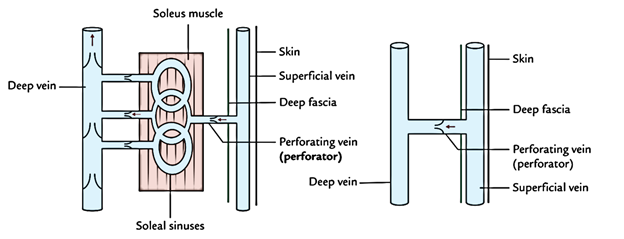Perforating Veins are so named due to the fact that they perforate the deep fascia. The venous channels between the superficial and deep veins are conveyed by them. The perforators are classified into 2 types: indirect and direct.
- Indirect perforators: They attach the superficial veins with the deep veins via muscular veins.
- Direct perforators: They attach the superficial veins with the deep veins directly.
Location of Perforators
The position of 5 or 6 perforators is rather continuous, as stated below:
A) An adductor canal (Hunterian) perforator: It attaches the great saphenous vein together with the femoral vein in the lower part of the adductor (Hunter’s) canal.
B) A knee perforator (Boyd’s perforator): It attaches the great saphenous vein together with the posterior tibial vein just below the knee and close to the medial border of tibia.
C) A lateral ankle perforator: It interacts the short saphenous vein together with the peroneal vein. It’s situated in the junction of middle and lower third of the leg.
D) 3 medial ankle perforators (of Cockett): All these are situated near the medial border of the lower third of tibia between the medial malleolus and mid-calf and attach the great saphenous vein together with the posterior tibial veins.
- Upper medial ankle perforator: It is located at the junction of the middle and lower third of the leg.
- Middle medial ankle perforator: It is located around 4 cm above the medial malleolus.
- Lower medial ankle perforator: It is located posteroinferior to the medial malleolus.
The 3 medial ankle perforators join with 1 another (by a series of venous arcades) to create the posterior arch vein.
Clinical Significance
- Calf pump and peripheral heart; In erect position, the venous return from the lower limb takes place against gravity and depends mostly on the contraction of calf muscles. Thus, these muscles are named calf heart.
- The soleus muscle includes venous sinuses full of blood. When soleus muscle contracts, it pumps the blood from its large venous sinuses into the deep veins, and when it’s relaxed it sucks the blood from the superficial veins, and the venous sinuses inside it are refilled. The unidirectional blood flow is kept by the valves in the perforating veins. Thus, the soleus is occasionally referred to as peripheral heart.
- The soleal sinuses are typical site for thrombosis and source of pulmonary embolism in sedentary people. The phlebitis of soleal sinus could possibly be dangerous since the spread of infection from here may damage the valves in the perforators.


 (50 votes, average: 4.78 out of 5)
(50 votes, average: 4.78 out of 5)